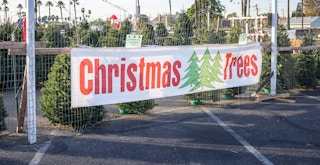Over the past few years, there’s been a major shortage of Christmas trees, in part due to the pandemic.
But the pandemic wasn’t the main contributing factor to the Christmas tree shortages we’ve been seeing. While supply chain issues certainly made things worse, these Christmas tree shortages have been a long time in the making.
Let’s break it all down so you can see what to expect in 2023 at your local tree farm — and why.
For more smart shopping tips and savings hacks, text HACKS to 57299. Then download the KCL app to save on all of your holiday decor.
Christmas trees take 8 – 15 years to reach their full height.

As you might expect, Christmas trees take a long time to grow. It actually takes them up to four years to grow just one foot!
After that, their growth can take off a lot faster depending on the type of tree, but generally speaking, it takes about 8 – 15 years for a tree to fully mature.
So the fresh Christmas trees you buy this year were planted between 2008 and 2015.

So let’s take a look at what was happening around 2008 for Christmas tree farmers.
Starting in 2007, Christmas tree farmers had a surplus of mature trees. Because they weren’t able to sell all their trees in 2007, there wasn’t as much room to plant new trees.
Another big thing started to rear its head in 2007 — the Great Recession — and everyone was trying to pinch pennies anywhere they could. Rather than buying a new live tree, many people chose to invest in a single artificial tree they could reuse for years. So because the demand was down, live trees got progressively more expensive.
And Christmas tree farmers were feeling the rocky economy just as hard as anyone else.
Related: How to Keep Your Christmas Tree Green & Fresh Through Christmas
We’re likely facing a shortage in 2023 due to holdover effects from the Recession — and Canadian wildfires.
The U.S. lost a lot of its Christmas tree acreage thanks to the Great Recession, and that fact is ongoing. It’s not like the number of trees will be restored to 2007 levels anytime soon. While we don’t really need to restore matured crops to their 2007 levels when we had a surplus, the issue of land is still a real one.
The Canadian wildfires are also a problem. Canada provides more than 50% of its Christmas tree supply to the rest of North America — and the U.S. buys 73% of that supply. This year, they’ll be exporting a much smaller percentage due to the wildfires in Canada.
Experts predict we’ll see Christmas tree shortages continue through at least 2024.
Even if the demand doesn’t end up being as off-kilter as it was in 2020 and 2021 during the height of the COVID-19 pandemic, the effects of the Great Recession crops are likely to last over a longer period of time — just like it took the economy many years to recover from the housing bubble burst.
We saw a Christmas tree shortage in 2022, too — along with inflated prices.
Last year marked the first year we hit a 15-year crop planted during the Recession. And while there were more trees available in the fall and winter of 2022 than in the year before, it was still slim pickings — and everything was more expensive.
Inflation on the whole peaked in 2022, and those who were selling trees marked up their prices accordingly.
Download the KCL app to add and redeem coupons in store




























































































